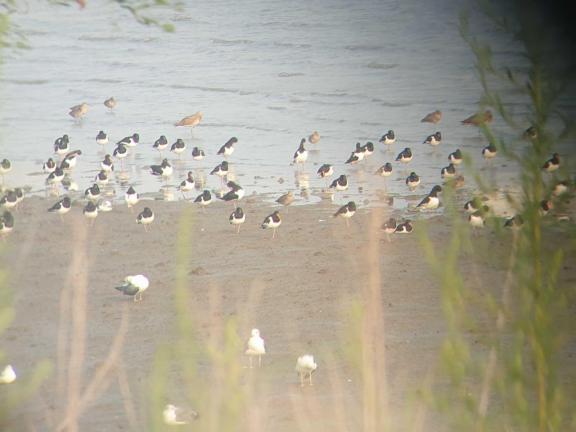Canaries in the Coal Mine? What Birds Tell Us About Climate Change
“Birds are indicators of the environment.
If they are in trouble, we know we'll soon be in trouble.”
- Roger Tory Peterson, an ornithologist and conservationist.
On Friday 18 August, I went birdwatching together with the other IEU interns as part of the Unit’s monthly Interns’ Day Programme. The interns had the opportunity to see various migratory birds along the East Asian-Australasian Flyway, including the Eurasian curlew, Far Eastern curlew, black-faced spoonbill, black-tailed gull, Eurasian oystercatcher, grey plover, common greenshank, and Bar-tailed Godwit. We were also educated on these birds’ conservation status and unique characteristics. For instance, the black-faced spoonbill is classified as an endangered species.[1] Interestingly, the Bar-tailed Godwit is arguably the world's most extreme long-distance migrant bird after traveling about 11,000 km non-stop from Alaska to New Zealand.[2]
Following the birdwatching event organized by the East Asian-Australasian Flyway Partnership (EAAFP), several reflections came to my mind, including seeing the birds from a climate change perspective. Thus, this blog summarizes my reflections backed by research on the value of the avian community amidst the changing climate.
Climate change not only poses and presents a clear danger to us as global citizens, but it also poses an existential threat to birds. Extreme variation in temperature and precipitation can affect their health and well-being, destroy habitats, disrupt migration patterns, and reduce food quantity and quality. These changes hold important lessons for us as, for want of a better analogy, birds can be seen as the canary in the coal mine.
It is estimated that between 50 billion and 430 billion birds roam the Earth.[3] Whether it is a Chaffinch in the UK, a rock pigeon in Ghana, or a Bar-tailed Godwit along the East Asian-Australasian Flyway, all of these species provide a range of ecosystem services. They can also offer climate solutions, albeit in unconventional ways.
First, many bird species consume fruits, seeds, and nuts. As a result of their movement, migratory birds can disperse the seeds over several kilometers. Once these seeds fall into areas with suitable ecological conditions, they germinate into a variety of tree species. Consequently, carbon sinks/storage can be enhanced due to this seed dispersal by migratory birds.
Second, many bird species, including hummingbirds and honeycreepers, assist in pollination. Many plants depend on bird pollinators for reproduction. Through pollination, birds help maintain and restore the diversity of plant communities. Through these ecosystem services, birds contribute to climate change mitigation.
Third, and most importantly, as a bellwether for the environment, birds are particularly sensitive to changes in their environment, such as fluctuations in temperature, food availability, and habitat loss. Monitoring the movement of bird populations can thus serve as an early warning system of global climatic change. For instance, the comings and goings of migratory birds are a sign of changing seasons. Taking these movements into account in our decision-making could be an important guide for climate-adaptive living.
Fourth, in the context of climate-health nexus, birds could offer a solution. On a more soothing note, birdwatching and listening to the melodious songs of birds have proven to have a healing effect. Proximity to nature and keeping our eyes on bird species nearby can calm those frazzled by urban living. Indeed, the direct and indirect impacts of birds on mental health continue to gain wide currency. For instance, a study by Joel Methorst et al. demonstrate a significant positive relationship between plant and bird species richness and mental health across all model variations controlling for a multitude of other factors.[4] Another study by Rachel Buxton et al. also conclude that bird diversity may yield mental health benefits for humans, through birdsong or feelings of connection to nature, based on a negative, significant association between bird species diversity and anxiety/mood disorder hospitalizations in a U.S. context.[5] Just imagine the therapeutic benefit that a singing bird could have for someone experiencing climate-induced mental health problems, which could include post-traumatic stress disorder, adjustment disorder, and depression due to the increased frequency of climate hazards and disasters.[6]
All birds, not just canaries, are unsung contributors to the growing awareness of climate change and the need for climate action. Do you want to better understand and prepare for the changing climate? Then, keep an eye on their migration patterns and movements!
Disclaimer: The views expressed in blogs are the author's own and do not necessarily reflect the views of the Independent Evaluation Unit of the Green Climate Fund.
[1] https://www.wwf.org.hk/en/reslib/species/blkfacespoonbill/
[2] http://www.birdskorea.org/Birds/Miscellaneous/BK-BM-Bartailed-Godwit-The-greatest-Migrant.shtml
[3] https://www.nationalgeographic.com/animals/article/how-many-birds-are-th...
[4] Methorst, J., Bonn, A., Marselle, M., Böhning-Gaese, K., & Rehdanz, K. (2021). Species richness is positively related to mental health–a study for Germany. Landscape and Urban Planning, 211, 104084.
[5] Buxton, R. T., Pearson, A. L., Lin, H. Y., Sanciangco, J. C., & Bennett, J. R. (2023). Exploring the relationship between bird diversity and anxiety and mood disorder hospitalisation rates. Geo: Geography and Environment, 10(2), e127.
[6] Padhy, S. K., Sarkar, S., Panigrahi, M., & Paul, S. (2015). Mental health effects of climate change. Indian journal of occupational and environmental medicine, 19(1), 3.


